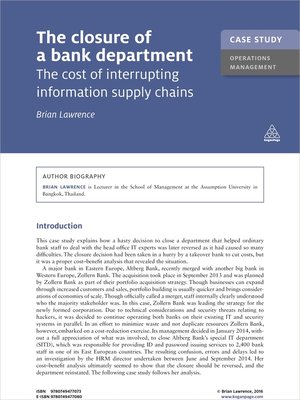The Closure of a Bank Department
ebook ∣ The Cost of Interrupting Information Supply Chains · Kogan Page Case Study Library
By Brian Lawrence

Sign up to save your library
With an OverDrive account, you can save your favorite libraries for at-a-glance information about availability. Find out more about OverDrive accounts.
Find this title in Libby, the library reading app by OverDrive.



Search for a digital library with this title
Title found at these libraries:
| Library Name | Distance |
|---|---|
| Loading... |
This real-life case study analyses how information supply chains are critical in the running of day to day operations of a bank corporation. It explores how a hasty decision to close a local branch department designed to aid staff on the ground to deal with the head office IT experts was later reversed. It had caused major communication issues, as well as delays and duplication of administrative work, thus affecting various levels of the information supply chain.
A major bank in Eastern Europe, Altberg Bank, recently merged with another big bank in Western Europe, Zollern bank. Banking has become a very competitive business, nationally and internationally. Bank charges, service offerings and budgets have to take this into account. Employees are expensive, with their salaries, office accommodation and other related costs. Banks do not have expensive machinery, raw materials or stock inventory, but they do have expensive employees tending to IT systems and equipment. When required to contain costs, or maximizing financial results from a merger, any top management would look closely at what could be pared down.
Aimed at students on supply chain and operations management courses, the case presents cost-benefit analysis, the interdependence of seemingly separate operations and the importance of information management.
This case study examines a fast changing fiercely competitive world where management is always under pressure to make decisions to improve financial performance. Readers are provided with insights into internal supply chains of communication and decision making. Readers are also able to develop an understanding of how and why security is a vital element in the running of IT systems in any financial institution.







